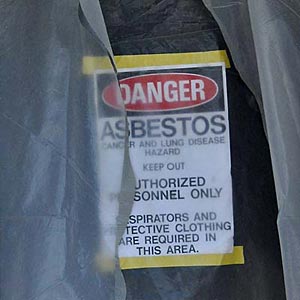Asbestos-Containing Materials (ACM) and Demolition
- National Emission Standards for Hazardous Air Pollutants (NESHAP) for Asbestos
- EPA Guidance on Asbestos-Containing Materials (ACM)
- Other EPA Asbestos Guidance
- What Kind of Regulations Apply to Removal of Asbestos from Buildings?
- Asbestos Accreditation
National Emission Standards for Hazardous Air Pollutants (NESHAP) for Asbestos
- There are specific federal regulatory requirements that require the identification of asbestos-containing materials (ACM) in many of the residential buildings that are being demolished or renovated by a municipality.
- There may also be state and local regulations that apply to the identification of such materials.
The NESHAP for asbestos apply to most demolition projects conducted by municipalities, counties and land banks.
The regulatory requirements were enacted to protect public health and welfare. They are good practices to follow, even if your demolition or renovation project that involves ACM in a residential building is not subject to the federal asbestos regulations.
Inspection
For demolitions that are subject to the asbestos NESHAP, the regulation requires a thorough inspection before demolition or renovation begins.
The residential structures, or the portion of the structures that will be demolished or renovated, must be thoroughly inspected for the presence of asbestos, including Category I and Category II non-friable ACM.
Information gathered during the thorough inspection allows the owner or operator to determine which requirements of the NESHAP for asbestos will apply to the demolition or renovation project. What we have provided here is only a brief summary of some of the requirements of the asbestos NESHAP.
Learn about requirements of the asbestos NESHAP
- Asbestos NESHAP
- Municipal Demolitions and the Asbestos NESHAP (June 2011) Presentation given during the 2011 National Asbestos Meeting
- State Demolition Information (including asbestos programs)
The asbestos NESHAP prohibits the reinstallation or installation of any insulating materials that contain commercial asbestos if the materials are either molded and friable or wet-applied and friable after drying. It is not recommended that other asbestos containing materials be reused.
Commercial Asbestos
- Asbestos in Your Home (EPA 745F93006) 1993 - lists typical kinds of ACM found in residential structures
- How Can People Be Exposed to Asbestos?
- Early Warning Report: Use of Unapproved Asbestos Demolition Methods May Threaten Public Health (EPA Inspector General Report No. 12-P-0125) 2011
EPA Guidance on Asbestos-Containing Materials (ACM) from the Applicability Determination Index (ADI)
EPA receives questions about whether or how the asbestos NESHAP regulations apply to a specific situation. EPA's answers to those questions are called "Applicability Determinations." They're available on the Applicability Determination Index (ADI), a searchable database.
Search the Applicability Determination Index (ADI)
- asbestos-containing flooring and mastic
- asbestos-containing roofing materials
- asbestos-containing vermiculite
- paint that contains asbestos
- asbestos in plaster and wall systems
- transite siding and similar materials
- window caulk, glazing compound, wiring and other similar materials
Other EPA asbestos guidance:
- Will a demolition method make ACM friable?
- How EPA's Asbestos Regulations Apply to Residential Buildings Used for Fire Training
- How EPA's Asbestos Regulations Apply to Municipal Demolition Activities
- Discovery of Asbestos After Demolition is Underway
- Protect Your Family from Asbestos-Contaminated Vermiculite Insulation
- Correspondence about Applicability of Asbestos NESHAP
A relevant guide is Arizona Department of Environmental Quality's Asbestos NESHAP Regulations for Demolition and Renovation: A Guide for County and Municipal Building Services Departments and Owner/Operators of NESHAP Facilities (November 2011) - see What is the Asbestos Renovation & Demolition Notification Requirement? for current info.
What kind of regulations apply to removal of asbestos from buildings and other structures?
-
federal regulations

- state regulations (generally)
- local regulations (sometimes)
What do the regulations typically entail?
- The regulations typically require that notifications be submitted to the appropriate government agencies before the work begins.
- There is often a fee that must be paid to a state or local government agency.
- Work practice requirements
- Waste disposal requirements
- Recordkeeping requirements
- Requirements may vary from one location to another
- Regulatory requirements of several government agencies can apply to a single project.
Where should I start?
Federal and state agency websites are a good starting point for determining the asbestos-related requirements that may apply at your location.
Asbestos accreditation
There are regulations that provide for the accreditation (also known as licensing or certification in some states) of people who do various types of asbestos work.
Although you may not be required to use an accredited worker for all municipal demolitions or renovations involving all kinds of residential structures (consult your local or state agency office that accredits workers for more information), it is a good practice to use accredited workers for all types of work involving ACM.
Alert
Alternative Asbestos Control Method (AACM)
EPA can approve alternatives to the work practice requirements in the asbestos NESHAP under procedures found at 40 C.F .R. § 61.12( d). EPA has not approved any alternatives. The Inspector General's office at EPA has warned against the use of unapproved alternatives.
- Early Warning Report: Use of Unapproved Asbestos Demolition Methods May Threaten Public Health - Report 12-P-0125 Dec. 14, 2011
- EPA's notification of rules and regulations regarding the demolition of asbestos-containing structures June 8, 2012
- Asbestos Control Method
- Guidance on how to request approval for an alternative control method
